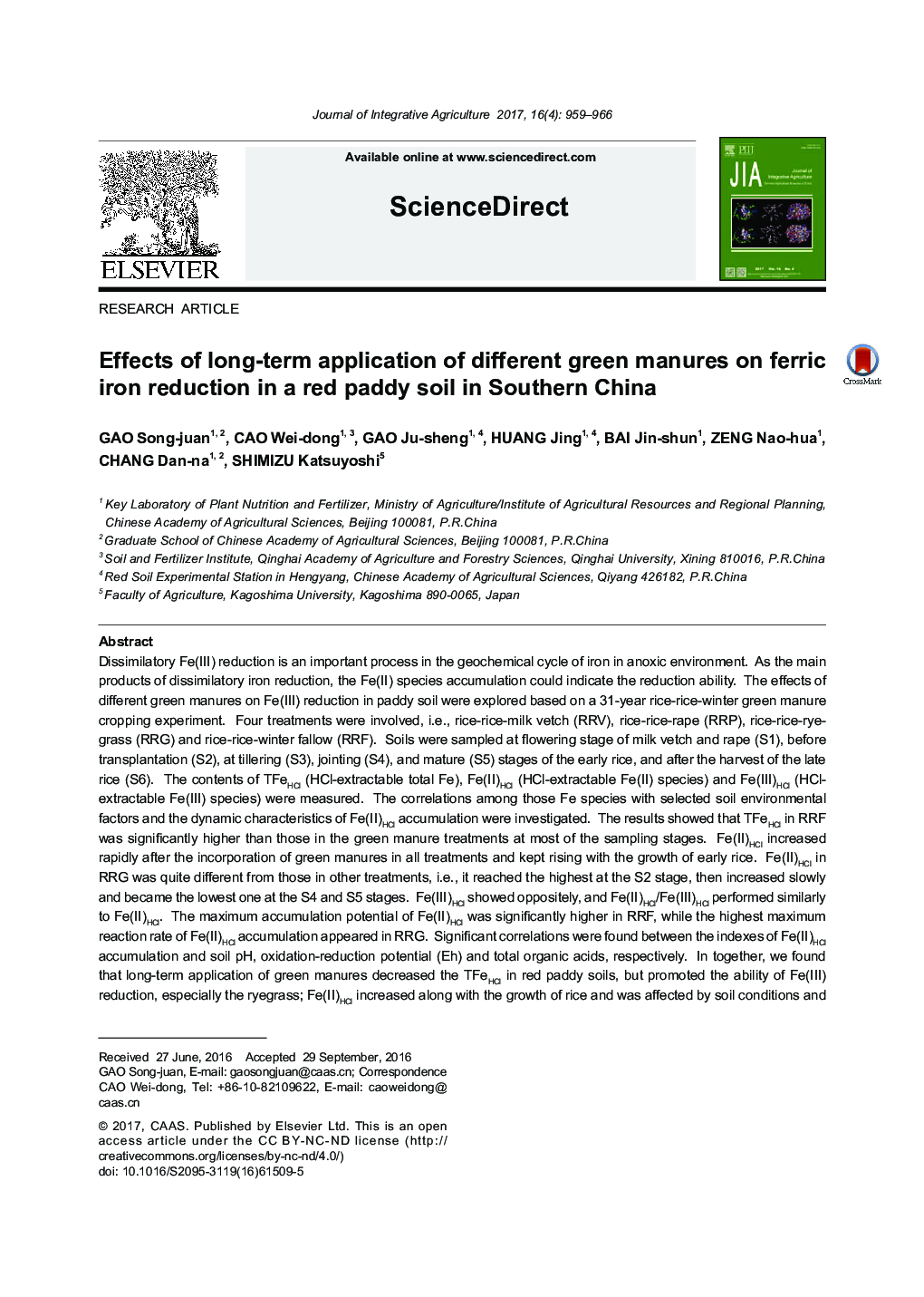| کد مقاله | کد نشریه | سال انتشار | مقاله انگلیسی | نسخه تمام متن |
|---|---|---|---|---|
| 8876046 | 1623710 | 2017 | 8 صفحه PDF | دانلود رایگان |
عنوان انگلیسی مقاله ISI
Effects of long-term application of different green manures on ferric iron reduction in a red paddy soil in Southern China
ترجمه فارسی عنوان
اثرات استفاده از زرادخانه های مختلف سبز بر کاهش آهن در خاک های قرمز در جنوب چین
دانلود مقاله + سفارش ترجمه
دانلود مقاله ISI انگلیسی
رایگان برای ایرانیان
کلمات کلیدی
کود کشاورزی سبز، خاکستری قرمز، کاهش آهن آهن، سیستم برداشت سبوس برنج، برنج زمستانه،
موضوعات مرتبط
علوم زیستی و بیوفناوری
علوم کشاورزی و بیولوژیک
علوم کشاورزی و بیولوژیک (عمومی)
چکیده انگلیسی
Dissimilatory Fe(III) reduction is an important process in the geochemical cycle of iron in anoxic environment. As the main products of dissimilatory iron reduction, the Fe(II) species accumulation could indicate the reduction ability. The effects of different green manures on Fe(III) reduction in paddy soil were explored based on a 31-year rice-rice-winter green manure cropping experiment. Four treatments were involved, i.e., rice-rice-milk vetch (RRV), rice-rice-rape (RRP), rice-rice-rye-grass (RRG) and rice-rice-winter fallow (RRF). Soils were sampled at flowering stage of milk vetch and rape (S1), before transplantation (S2), at tillering (S3), jointing (S4), and mature (S5) stages of the early rice, and after the harvest of the late rice (S6). The contents of TFeHCl (HCl-extractable total Fe), Fe(II)HCl (HCl-extractable Fe(II) species) and Fe(III)HCl (HCl-extractable Fe(III) species) were measured. The correlations among those Fe species with selected soil environmental factors and the dynamic characteristics of Fe(II)HCl accumulation were investigated. The results showed that TFeHCl in RRF was significantly higher than those in the green manure treatments at most of the sampling stages. Fe(II)HCl increased rapidly after the incorporation of green manures in all treatments and kept rising with the growth of early rice. Fe(II)HCl in RRG was quite different from those in other treatments, i.e., it reached the highest at the S2 stage, then increased slowly and became the lowest one at the S4 and S5 stages. Fe(III)HCl showed oppositely, and Fe(II)HCl/Fe(III)HCl performed similarly to Fe(II)HCl. The maximum accumulation potential of Fe(II)HCl was significantly higher in RRF, while the highest maximum reaction rate of Fe(II)HCl accumulation appeared in RRG. Significant correlations were found between the indexes of Fe(II)HCl accumulation and soil pH, oxidation-reduction potential (Eh) and total organic acids, respectively. In together, we found that long-term application of green manures decreased the TFeHCl in red paddy soils, but promoted the ability of Fe(III) reduction, especially the ryegrass; Fe(II)HCl increased along with the growth of rice and was affected by soil conditions and environmental factors, especially the water and redox ability.
ناشر
Database: Elsevier - ScienceDirect (ساینس دایرکت)
Journal: Journal of Integrative Agriculture - Volume 16, Issue 4, April 2017, Pages 959-966
Journal: Journal of Integrative Agriculture - Volume 16, Issue 4, April 2017, Pages 959-966
نویسندگان
Song-juan GAO, Wei-dong CAO, Ju-sheng GAO, Jing HUANG, Jin-shun BAI, Nao-hua ZENG, Dan-na CHANG, Katsuyoshi SHIMIZU,
